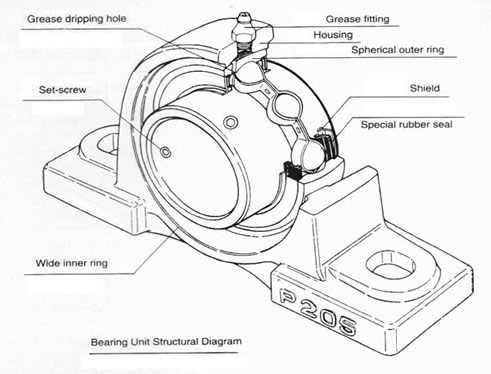Drew Riley
Well-Known Member
I'm starting this thread based on some recent discussion that I've seen brought up over and over again, but seemingly never with a solid, matter of fact answer.
There seems to be a bit of confusion surrounding the question of whether or not one should grease a pillow block bearing, especially if they are listed as "sealed". The other question is "why are there grease zercs if we're not supposed to grease them?"
Well, either we will lay both questions to rest, or create even more confusion in the process!
It is my understanding that "sealed" pillow blocks DO in fact require routine greasing and maintenance.
First, let's look at a diagram of a traditional pillow block bearing:

The "seal" of the sealed bearing is referred to in the diagram as a "special rubber seal", and this usually has a "shield" around the outside of the bearing, protecting this seal.
If you remove the bearing from the housing, you are left with something that looks like this:

Notice the groove around the circumference of the spherical outer ring, and more importantly the small hole. This hole is a grease port, which is ideally, BUT VERY RARELY lined up with the the grease zerc in the housing.
In other words, when, these bearings are set into their housing, these small grease holes are SUPPOSED to be lined up with the zircs, but rarely are. Personally, I try to line these up myself whenever I get a new PB bearing. Otherwise, when you pump grease into the zercs, you're just going to sqeeze out between the housing and the outer ring. I believe the groove is there to help compensate for this and guide the grease into the hole, but I try not to rely solely on that. Also, some bearings don't even have this groove, but just a hole.
Simply remove the zerc fitting and rotate the bearing such that the holes are centered up on eachother, and then replace the zerk.
Now, how much grease is enough?
Some say to pump it in until it starts squeezing out of the outer seal. Personally, I think this is too much, as you risk blowing your seals out, and allowing dirt and other debris to get in the bearing. This excess grease also becomes a magnet for all kinds of dirt, dust and debris which can eventually find its way into a blown seal and destroy your bearings. Finally, too much grease in a bearing can cause excess heat/friction.
Now, all that said, the seals WILL allow used/excess grease/oil to weep out of them. This is why it's important to re-grease every now and then.
Personally, I think a couple pumps of the average grease gun will suffice.
Hope this helps!
There seems to be a bit of confusion surrounding the question of whether or not one should grease a pillow block bearing, especially if they are listed as "sealed". The other question is "why are there grease zercs if we're not supposed to grease them?"
Well, either we will lay both questions to rest, or create even more confusion in the process!
It is my understanding that "sealed" pillow blocks DO in fact require routine greasing and maintenance.
First, let's look at a diagram of a traditional pillow block bearing:

The "seal" of the sealed bearing is referred to in the diagram as a "special rubber seal", and this usually has a "shield" around the outside of the bearing, protecting this seal.
If you remove the bearing from the housing, you are left with something that looks like this:

Notice the groove around the circumference of the spherical outer ring, and more importantly the small hole. This hole is a grease port, which is ideally, BUT VERY RARELY lined up with the the grease zerc in the housing.
In other words, when, these bearings are set into their housing, these small grease holes are SUPPOSED to be lined up with the zircs, but rarely are. Personally, I try to line these up myself whenever I get a new PB bearing. Otherwise, when you pump grease into the zercs, you're just going to sqeeze out between the housing and the outer ring. I believe the groove is there to help compensate for this and guide the grease into the hole, but I try not to rely solely on that. Also, some bearings don't even have this groove, but just a hole.
Simply remove the zerc fitting and rotate the bearing such that the holes are centered up on eachother, and then replace the zerk.
Now, how much grease is enough?
Some say to pump it in until it starts squeezing out of the outer seal. Personally, I think this is too much, as you risk blowing your seals out, and allowing dirt and other debris to get in the bearing. This excess grease also becomes a magnet for all kinds of dirt, dust and debris which can eventually find its way into a blown seal and destroy your bearings. Finally, too much grease in a bearing can cause excess heat/friction.
Now, all that said, the seals WILL allow used/excess grease/oil to weep out of them. This is why it's important to re-grease every now and then.
Personally, I think a couple pumps of the average grease gun will suffice.
Hope this helps!
Last edited:


